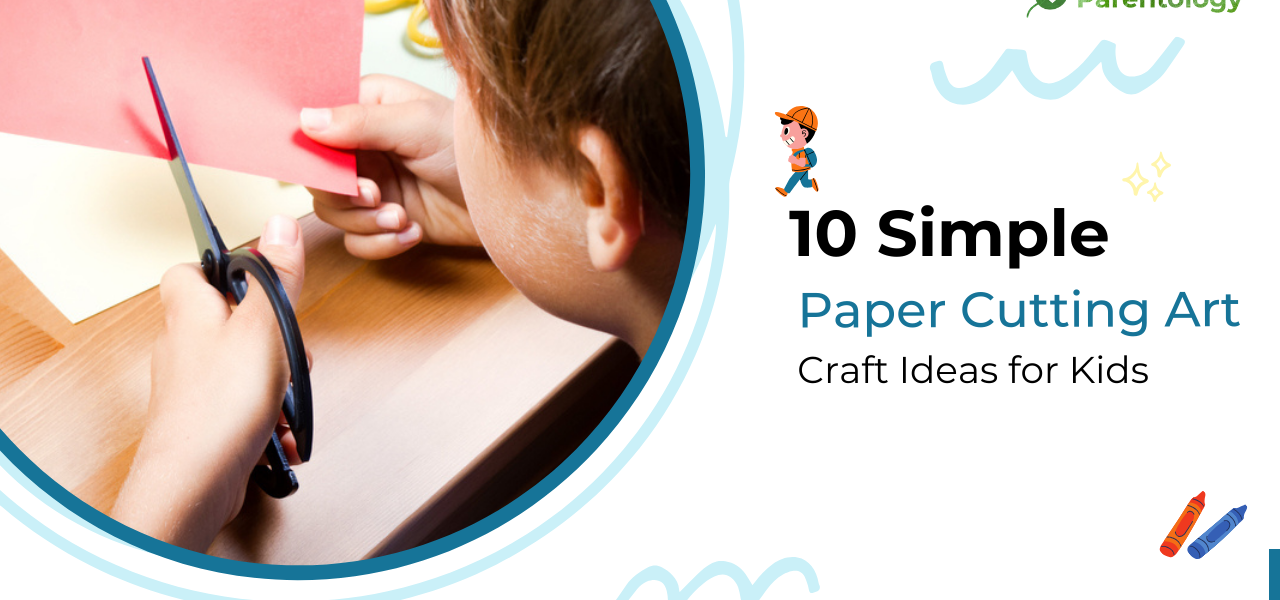10 Simple Paper Cutting Art and Craft Ideas for Kids
Paper cutting art for kids is an engaging and educational activity that sparks creativity and imagination. From simple shapes to intricate designs, exploring paper cutting crafts can be a fantastic way to entertain your kids while enhancing their fine motor skills and artistic abilities.
Introduction to Paper Cutting Art
Paper cutting, also known as papercutting or paper art, involves the creation of intricate designs by cutting paper with scissors or a craft knife. It’s a versatile craft that allows children to create various shapes, patterns, and scenes using different types and colors of paper.
Getting Started: Materials Needed
Before diving into these exciting paper cutting art projects, gather the following materials:
- Colored construction paper
- Safety scissors (for younger children, consider using safety scissors with blunt tips)
- Craft knife (to be used by older children under adult supervision)
- Glue stick
- Pencil and eraser
- Ruler
1. Simple Shapes Cutting
- Description: Introduce your child to paper cutting by starting with simple shapes like circles, squares, triangles, and hearts. Let them practice cutting along the lines to create these basic shapes.
- Benefits: Develops hand-eye coordination and fine motor skills. Encourages creativity by exploring different shapes and colors.
2. Animal Silhouettes
- Description: Create animal silhouettes by tracing or drawing simple animal shapes on paper and cutting them out. Stick the silhouettes onto contrasting paper for a stunning effect.
- Benefits: Helps kids recognize shapes and learn about different animals. Encourages storytelling and imaginative play.
3. Paper Snowflakes
- Description: Fold a square or circular paper into intricate patterns and cut out sections to reveal unique snowflake designs. Unfold to see the beautiful symmetrical creations.
- Benefits: Enhances understanding of symmetry. Teaches precision and patience while cutting intricate patterns.
4. Alphabet Letters Collage
- Description: Cut out letters of the alphabet from different colored papers and create a collage. Children can learn letters while having fun arranging them creatively.
- Benefits: Aids in letter recognition and early literacy skills. Boosts creativity through arranging and designing.
5. Paper Doll Chains
- Description: Cut paper strips and fold them accordion-style to create paper doll chains. Draw or color the dolls before cutting to add a personal touch.
- Benefits: Develops cutting and folding skills. Encourages creativity in designing dolls and costumes.
6. Landscape Scenes
- Description: Cut out elements like trees, flowers, houses, and sun from colored papers to create a beautiful landscape scene. Arrange and stick them onto a background paper.
- Benefits: Encourages storytelling and imaginative play. Teaches composition and arrangement in art.
7. Pop-up Cards
- Description: Cut out shapes or designs that can be folded and pop up when the card is opened. Kids can create their own unique cards for special occasions.
- Benefits: Enhances creativity and design skills. Teaches the mechanics of pop-up structures.
8. Decorative Paper Lanterns
- Description: Cut paper strips and create accordion folds to form paper lanterns. Add decorative elements and glue the ends together to make a lantern shape.
- Benefits: Develops cutting, folding, and crafting skills. Enhances understanding of geometric shapes.
9. Storybook Illustrations
- Description: Cut out characters, scenes, and objects from a favorite storybook and create illustrations on paper. Encourage kids to reenact the story using their cutouts.
- Benefits: Enhances comprehension and storytelling abilities. Encourages creative interpretation of stories.
10. Paper Mosaics
- Description: Cut colored papers into small shapes and arrange them to create mosaic-like designs. Stick them onto a base paper to form vibrant and colorful patterns.
- Benefits: Develops fine motor skills and patience. Encourages creativity in arranging shapes and colors.
Exploring Paper Cutting Art – A Journey of Creativity
Importance of Paper Cutting Art for Kids
Paper cutting activities hold significant importance in a child’s developmental journey:
- Enhanced Fine Motor Skills: Engaging in paper cutting helps children refine their hand-eye coordination and dexterity, crucial for their overall motor skill development.
- Boosted Creativity: Crafting with paper fosters imagination and creativity. Children can explore various shapes, colors, and designs, stimulating their innovative thinking.
- Educational Value: Beyond being a fun activity, paper cutting can serve as an educational tool. It aids in learning shapes, alphabets, and storytelling concepts.
Safety Tips for Paper Cutting Activities
Ensuring a safe environment during paper cutting sessions is paramount:
- Supervision: Always supervise younger children during paper cutting activities. For older kids using craft knives, provide clear instructions and monitor their usage.
- Appropriate Tools: Use child-friendly scissors with blunt tips for younger kids. Older children can use craft knives under adult supervision.
- Workspace Setup: Designate a well-lit and clutter-free workspace with a protective surface for cutting activities.
Encouraging Creativity through Paper Cutting
Beyond structured projects, encouraging creativity can open new avenues:
- Free Expression: Encourage children to create their designs and patterns. Allow them to explore their creativity freely.
- Variety of Materials: Introduce different types of paper, including textured, patterned, or colored papers, to enhance their artistic expression.
- Theme-based Projects: Introduce themes or stories and ask children to create paper cutting scenes based on those themes.
DIY Paper Cutting Kit for Kids
Consider creating a DIY paper cutting kit to facilitate your child’s artistic endeavors:
- Assorted Papers: Include various types of papers such as construction paper, tissue paper, or colored cardstock.
- Child-Safe Scissors: Ensure you have both blunt-tip and pointed-tip safety scissors suitable for different age groups.
- Craft Knife (Under Supervision): For older children, include a craft knife with proper safety guidelines and supervision.
- Glue Stick and Markers: Add glue sticks and markers for coloring or adding details to their creations.
Conclusion
Engaging in paper cutting art for kids is an excellent way to foster creativity, fine motor skills, and imaginative thinking. These simple and entertaining projects allow children to explore their artistic abilities while having fun.
FAQs about Paper Cutting Art for Kids
Q 1: What age is suitable for paper-cutting art activities?
Ans 1: Paper-cutting art can be introduced to children around 4-5 years old, with supervision for younger kids.
Q 2: How can I ensure safety while my child is engaged in paper cutting?
Ans 2: Use child-friendly scissors with blunt tips and supervise older kids when using craft knives.
Q 3: Are there any benefits of paper cutting art for kids?
Ans 3: Yes, it helps develop fine motor skills, encourages creativity, and enhances hand-eye coordination.
Q 4: Can paper cutting activities help in learning other skills?
Ans 4: Certainly, kids can learn shapes, colors, letters, and storytelling through paper cutting art.
Q 5: What should I do if my child struggles with cutting?
Ans 5: Start with simpler activities, use thicker paper, and encourage practice to improve cutting skills gradually.
Q 6: How can I make paper cutting more engaging for kids?
Ans 6: Incorporate storytelling, allow them to choose themes, and appreciate their creations to keep them motivated.
Q 7: Is paper cutting art a messy activity?
Ans 7: Generally, paper cutting is a clean activity, but supervise younger kids to avoid paper scraps scattered around.
Q 8: Can paper cutting art be used for educational purposes?
Ans 8: Absolutely, it can be utilized to teach shapes, letters, numbers, and storytelling concepts.
Q 9: What precautions should I take when using a craft knife?
Ans 9: Ensure proper handling and storage, teach older kids safe cutting techniques, and always supervise their use.
Q 10: How can parents encourage creativity through paper cutting art?
Ans 10: Provide a variety of papers, themes, and encourage kids to experiment with different designs and combinations.
Paper Cutting Art for Kids – A Creative Journey
Encouraging your child’s creativity through paper cutting art can be an exciting journey filled with discovery and imagination. These simple yet engaging projects provide an avenue for kids to express themselves artistically while developing essential skills. Embrace the joy of crafting with paper and witness your child’s imagination soar!
For more inspiration and ideas on kids’ crafts and activities, visit Parentology to explore a wealth of resources on fostering creativity and learning in children.



